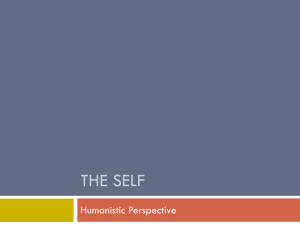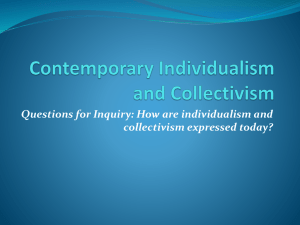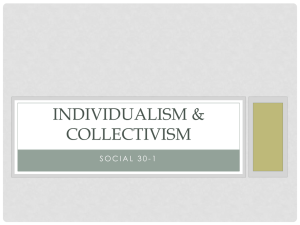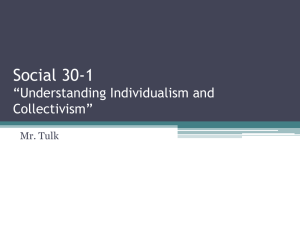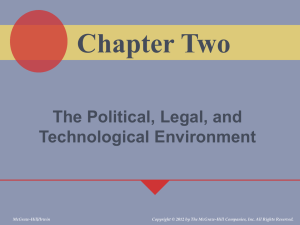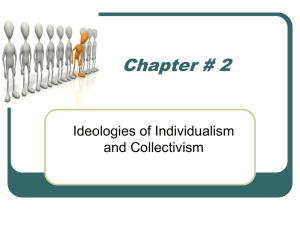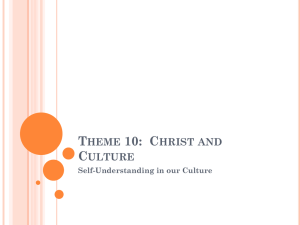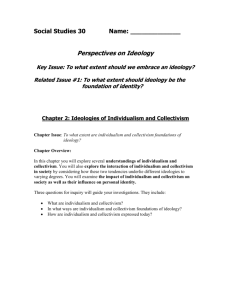Ideologies of Individualism & Collectivism Chapter Two To What
advertisement
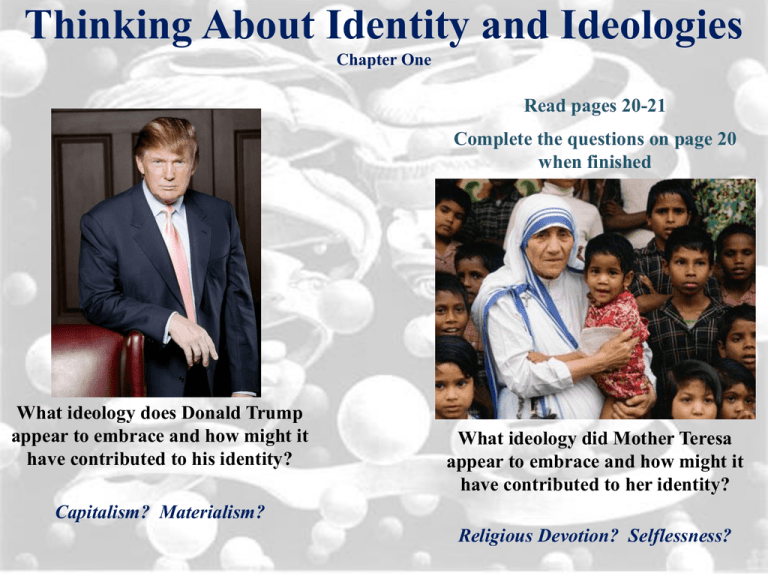
Thinking About Identity and Ideologies Chapter One Read pages 20-21 Complete the questions on page 20 when finished What ideology does Donald Trump appear to embrace and how might it have contributed to his identity? What ideology did Mother Teresa appear to embrace and how might it have contributed to her identity? Capitalism? Materialism? Religious Devotion? Selflessness? To What Extent Are Ideology and Identity Interrelated? Chapter One Read Page 22 Write out the issue question for Chapter One Using the handout provided, read and complete the required work for Chapter One Due: Today On your own time, create a list where you write out the following Chapter One Terms IDEOLOGY a set of principles or ideas that explains your world and your place within it, which is based on certain assumptions about human nature and society and provides an interpretation of the past, an explanation of the present and a vision for the future. a collection of ideologies all committed to the principle of the dignity and freedom of the individual as the foundation for society. Liberalism has faith in human progress and tends to favour decentralized power, both in political and economic affairs, and respect for the sovereignty of the reasoning individual worldview a collection of beliefs about life and the universe held by an individual or a group, the lens through which the world is viewed by an individual or a group, the overall perspective from which the world is interpreted. Ideologies of Individualism & Collectivism Chapter Two Before we begin, go back to: Beliefs and Values Inventory: Where Do You Fit In? (Page 30) Complete the entire activity Review Ideologies of Individualism & Collectivism Chapter Two Describe what you believe a society, that emphasized individualism, would look like… Review the Bumper Stickers on this slide and on Page 62 and answer the following questions: Which of the bumper stickers express a perspective based more on individualism? Which ones represent a perspective based more on collectivism? What would you put on a bumper sticker to best represent a perspective based more on individualism? To What Extent Are Individualism and Collectivism Foundations of Ideology? Chapter Two Read Page 63 Write out the issue question for Chapter Two Understanding Individualism and Collectivism (Pgs 64-70) Historical Individualism and Collectivism Timeline After reading pages 64-70, by yourself or in a group no larger than two, create a timeline in which you: • • Chronologically highlight key examples of individualism and collectivism Identify from what perspective (individualism or collectivism) the event would be important to include on the timeline and why • When completed, title your timeline and compare it with that of another group Understanding Individualism and Collectivism (Pgs 64-70) Historical Individualism and Collectivism Timeline Examples Understanding Individualism and Collectivism (Pgs 64-70) Historical Individualism and Collectivism Timeline After reading pages 64-70, by yourself or in a group no larger than two, create a timeline in which you: • • Chronologically highlight key examples of individualism and collectivism Identify from what perspective (individualism or collectivism) the event would be important to include on the timeline and why • When completed, title your timeline and compare it with that of another group Principles of Individualism and Collectivism (Pgs 71-79) You will be completing this section using the handout provided: Individualism and Ideology Case Studies: Obama’s attempt at reforming Health Care American Health Care versus Canadian Health Care Video 123 minutes Don’t forget the worksheet! Principles of Individualism and Collectivism (Pgs 80-86) You will be completing this section using the handout provided: Individualism vs. Collectivism Case Study: Hutterite Court Challenge Writing Assignment I Balancing Individual Needs With the Public/Common Good Smoking Ban, Cell Phone Ban, Curfews, Etc. In groups of 3-4, using the examples above, write a statement in which you respond to the following: How does our society balance the needs of individuals with those of the public good? For each of the issues, be sure to include a list of: Societies needs Individuals needs A balanced response Balancing Individual Needs With the Public/Common Good Complete the following: Chapter Two (pp. 76-77-Investigation - #1) Chapter Two (pp. 92-93- Investigation - #1) Chapter Two (pp. 96-97-Voices - #1) Handout: Dilemmas Facing a Liberal Democracy Balancing Individual Needs With the Public/Common Good Trudeau – October Crisis Patriot Act Writing Assignment II Political & Economic Spectrums and Ideologies What is a political and/or economic spectrum? A political (economic) spectrum is a way of modeling different political (economic) positions by placing them upon one or more geometric axes symbolizing independent political (economic) dimensions What might these spectrums include? Examples? Political Right Wing Left Wing Communism Socialism Fascism Dictatorships Conservatism Liberalism Lets take a look… Take a Spectrum Test Or This Short One Economic Centrally Planned Laissez Faire Free Market Command Capitalism Collectivism Individualism Political Spectrum and Ideologies With a partner, review the following handouts on Political/Economic Spectrums and Ideologies As you review, create a list of at least ten questions that will assist you on your unit exam Write multiple choice questions only In your questions, you may include the following formats: Basic Knowledge Application - (use knowledge in context) Analysis, Synthesis and Evaluation (make a decision) Also, you may include the following types: Complete the statement Which of the following Use of "not," "except," and "least" (negative choices) Include answers (and explanations) for all questions On your own time, create a list where you write out the following Chapter Two Terms COLLECTIVISM COLLECTIVISM a current thinking that values the goals of the group and the common good over the goals of any one individual. “The goals of the many outweigh the goals of one.” Charles Dickens A Tale of Two Cities Adherence to collective norms faithful observance of the norms or standards imposed on members of a group as a condition of membership in the group. These norms can relate to conduct, values or appearance. COLLECTIVE IDENTITY the identity that you share with other people as a member of a larger social group, such as a linguistic, faith, cultural or ethnic group. Individuals have both individual identities and collective identities. COLLECTIVE RESPONSIBILTY holding a whole group or collective responsible for the actions of individuals (or individual groups) within the group or collective. COMMON GOOD the good of the community, something that benefits the public health, safety and/or well-being of society as a whole. COMPETITION the act or an instance of competing or contending with others (for example, for supremacy, a position or prize. Competition is seen as an incentive for individuals and groups to work harder and more effectively CO - OPERATION working together to the same end; a principle emphasized by collective ideologies Economic EQUALITY a principal common to collective ideologies which can have different meanings depending on the person or the ideology. Governments may try to foster economic equality through tax policies and by ensuring that all people earn equal wages for work of similar value. ECONOMIC FREEDOM the freedom to buy what you want and to sell your labour, idea or product to whomever you please. INDIVIDUALISM a current of thinking that values the freedom and worth of the individual, sometimes over the security and harmony of the group. INDIVIDUAL RIGHTS AND FREEDOMS a key principle of individualism and an important feature of liberal democracies; examples include freedom of religion, freedom of association and the right to life, liberty and the security of the person. LIBERALISM a collection of ideologies all committed to the principle of the dignity and freedom of the individual as the foundation for society. Liberalism has faith in human progress and tends to favour decentralized power, both in political and economic affairs, and respect for the sovereignty of the reasoning individual. something that is owned by an individual, including real estate, other forms of physical possessions and intellectual property. The right to the protection of private property is a central principle of Liberalism and is seen as a natural extension of the concept of the worth of each individual. PRIVATE PROPERTY PUBLIC PROPERTY anything (for example, land, buildings or vehicles) not privately owned by individuals. Generally speaking, public property is owned by the state or community and managed according to the best interests of the community. RULE OF LAW a key principle in liberal democracies that states that every individual is equal before the law and all citizens are subject to the law. SELF-INTEREST one’s personal interest or advantage. Unit One Exam Consists of: 30 M.C. Questions* & Short Answer (26 Marks)* *Subject to change

